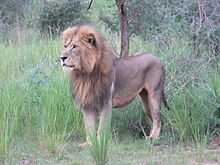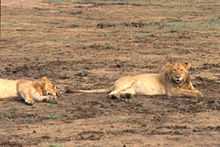Congo lion
| Congo lion | |
|---|---|
 | |
| Male in Murchison Falls | |
| | |
| Female in Murchison Falls | |
| Scientific classification | |
| Kingdom: | Animalia |
| Phylum: | Chordata |
| Class: | Mammalia |
| Order: | Carnivora |
| Family: | Felidae |
| Genus: | Panthera |
| Species: | P. leo |
| Subspecies: | P. l. azandica |
| Trinomial name | |
| Panthera leo azandica (Allen, 1924) | |
| Synonyms | |
|
Panthera leo hollisteri | |
Congo lion or Northeast Congo lion (Panthera leo azandica), also known as Uganda lion, was proposed as a lion subspecies from northeastern Belgian Congo and western parts of Uganda.[1]
Taxonomic history

In 1924, the American zoologist Allen proposed the trinomen Leo leo azandicus, and described a male lion as type specimen that was obtained by the American Museum of Natural History. This individual was killed in 1912 by museum staff as part of a zoological collection comprising 588 carnivore specimens. Allen admitted a close relationship to L. l. massaicus regarding cranial and dental characteristics but argued that his type specimen differed in pelage coloration.[2]
The British taxonomist Pocock subordinated lions to the genus Panthera in 1930 when he wrote about Asian lions.[3] Three decades later, Ellerman and Morrison-Scott recognized just two lion subspecies, namely the Asiatic P. l. persica and the African P. l. leo.[4]
Distribution and population status

Congo lions are primilary found on the northeastern part of the Democratic Republic of the Congo, some exist on the western part of Uganda, the southeastern part of the Central African Republic, including a few regions of South Sudan. They formerly existed in the Rwanda. They are the biggest apex predators of the savannas where they hunt and feed on zebras and antelopes. They also live in grasslands and forests.
Like the rest of the lion subspecies of other African ranges, the Congo lion population is currently decreasing by the loss of habitat and lack of preys.
Conservation status
No captive individual of Congolese lions is registered in the International Species Information System.[5] Northeast Congo lions are found mostly in various national parks in the Belgian Congo and Uganda, such as the Murchison Falls, Virunga and Queen Elizabeth National Park. They formerly lived in the national parks from Rwanda, until they died from the poison during and after the genocide.
References
- ↑ Allen, G. M. (1939). A Checklist of African Mammals. Bulletin of the Museum of Comparative Zoology at Harvard College 83: 1–763.
- ↑ Allen, G. M. (1924). Carnivora Collected by The American Museum Congo Expedition. Bulletin of the American Museum of Natural History 47: 73–281.
- ↑ Pocock, R. I. (1930). The lions of Asia. Journal of the Bombay Natural Historical Society 34: 638–665.
- ↑ Ellerman, J. R., and T. C. S. Morrison-Scott. (1966). Checklist of Palaearctic and Indian Mammals 1758 to 1946. Second edition. British Museum (Natural History), London.
- ↑ Barnett, R., Yamaguchi, N., Barnes, I., Cooper, A. (2006). The origin, current diversity and future conservation of the modern lion (Panthera leo). Proceedings of the Royal Society B 273 (1598): 2119–2125. doi:10.1098/rspb.2006.3555 PMID 16901830